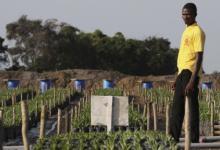
Typical street scene in Santa Ana, El Salvador. (Photo: iStock)
IMF Survey : Sierra Leone Gets $102 Million in Extra IMF Financing, Debt Relief
March 24, 2015
- Financing package comprises loan installment, loan topup, grant
- Ebola outbreak, drop in iron ore prices dealt severe blow to economy
- Government crafting post-Ebola strategy to revive economic activity
The IMF Executive Board approved a loan and grant package for Sierra Leone that includes $102 million in extra financing to help the West African country counter a slump in economic activity engendered by the Ebola outbreak.

Palm nursery in Pujehun, Sierra Leone, where non-mineral economy shrank in 2014 as Ebola outbreak cut activity (photo: Simon Akam/Reuters/Newscom)
RESOURCES TO FIGHT EBOLA
The package comprises the release of part of the country’s existing IMF financing arrangement, a topup of the loan total, and debt relief funded by an IMF grant.
The Board approved a $12 million loan payout to Sierra Leone under the three-year Extended Credit Facility arrangement approved by the IMF Board in 2013. The Board also boosted financing under the loan arrangement by an extra $73 million, in a move aimed at generating the fiscal room to maneuver in tackling the Ebola epidemic and at meeting Sierra Leone’s balance of payment needs.
In addition, Sierra Leone became the second country—after Liberia—to benefit from grants from a newly established trust set up to help low-income countries recover from natural disasters. The Board approved a grant of $29 million from the catastrophe containment window of the Catastrophe Containment and Relief Trust to provide debt relief to Sierra Leone, amounting to 20 percent of the country’s quota, or subscription, in the IMF.
The package of IMF financing for Sierra Leone draws on $100 million in debt relief funded by IMF grants, announced last month. The debt relief follows $130 million in emergency assistance the IMF disbursed in September 2014 to the African countries worst hit by the Ebola outbreak—Guinea, Liberia, and Sierra Leone.
Financing for Guinea, Liberia
On February 11 the IMF Board approved release of $25.9 million to Guinea under the West African country’s existing IMF-backed program, and boosted financing under the program by an extra $37.7 million, also to help combat Ebola. On February 23 the Board approved $36.5 million in a debt relief grant to Liberia and a $45.6 loan payout to Liberia under the Rapid Credit Facility.
The new Catastrophe Containment and Relief Trust is a permanent feature in the IMF tool kit. It makes available grants to provide debt relief to eligible low-income countries recovering from a catastrophic natural disaster or seeking to contain the potentially catastrophic spread of a life-threatening epidemic within and across international borders.
The debt relief initiative and additional lending to the Ebola-hit countries were outlined by IMF Managing Director Christine Lagarde in November 2014 in Brisbane, Australia to heads of state of the G-20 group of advanced and emerging economies. Sierra Leone becomes the second country, after Liberia, to receive IMF grants to help contain an evolving natural disaster with international spillover effects.
Twin shocks
IMF staff said in a report that the Ebola outbreak and a sharp drop in iron ore prices have dealt a severe blow to Sierra Leone’s economy. These twin shocks have prompted a deep slump in economic activity, with output set to shrink by about 13 percent in 2015 after estimated growth of 6 percent in 2014.
The Ebola epidemic has disrupted production and distribution channels for basic consumer goods, leading to lost incomes and heightened inflationary pressures. The population of orphans, the food insecure, and the vulnerable has increased significantly, stretching thin the current social protection system.
As world iron ore prices halved in 2014, the main mining company stopped operating and activity slumped in the second half of the year in an industry that accounts for one quarter of Sierra Leone’s economy and half of its exports.
Ebola disruption
The non-mineral economy contracted in 2014 as the Ebola outbreak reduced activity in agriculture, construction, tourism, and services; and investment projects were scaled back. Activity has also been disrupted in labor-intensive sectors such as hospitality, due to travel bans and a substantial reduction in government- and donor-funded projects.
Sierra Leone’s government is currently working with development partners to craft a post-Ebola recovery strategy that would indentify measures to revive economic activity, focusing on health, education, and agriculture.


